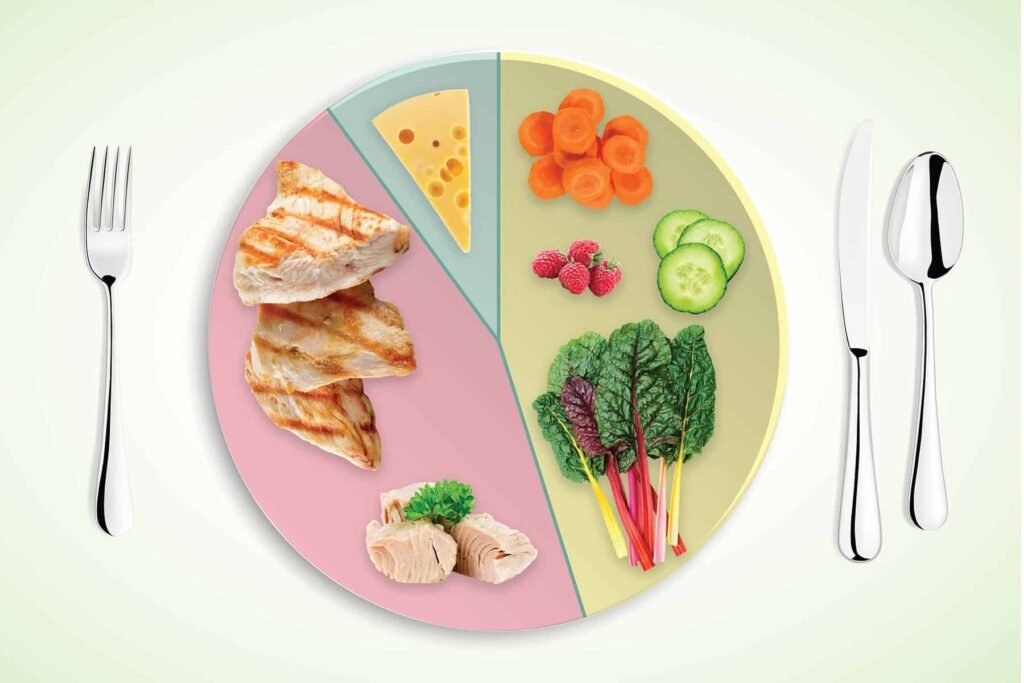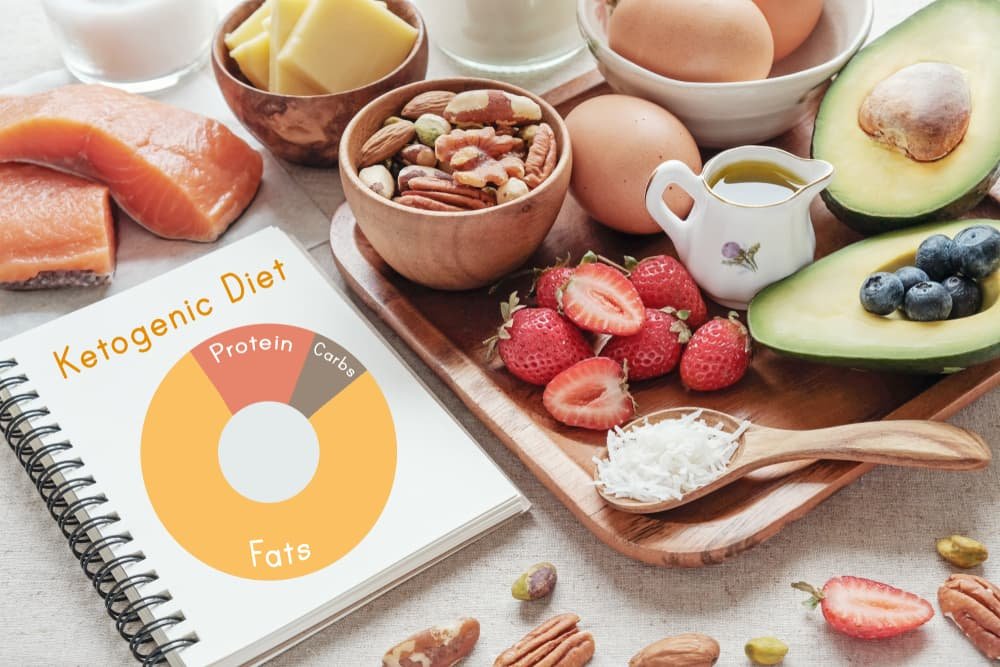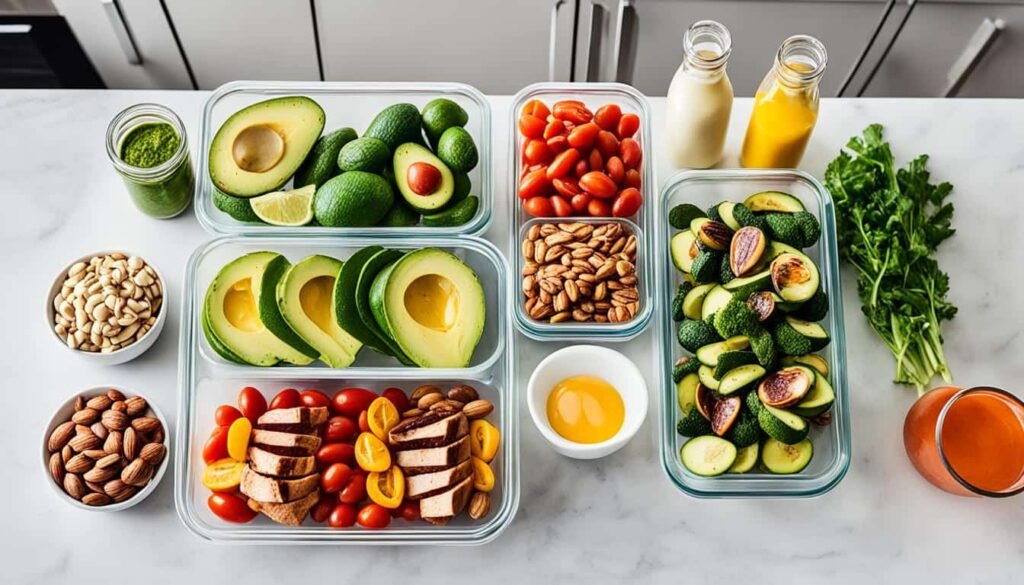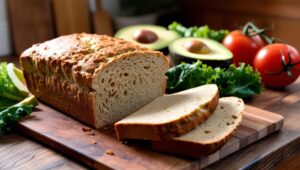Table of Contents
ToggleStarting the keto diet might seem tough, but it’s easier than you think. I’ve been on this journey and I’m here to help you. The keto diet can help with weight loss, better health, or just finding a new way to feed your body.
The keto diet, also known as the “keto diet,” is a new way to eat that’s getting a lot of attention. It cuts down on carbs and increases healthy fats. This puts your body into a state called ketosis. In ketosis, your body uses fat for energy, which can lead to many benefits.
Key Takeaways
- The keto diet is a low-carb, high-fat diet that puts the body into a state of ketosis, where it burns fat for energy.
- The keto diet has been shown to offer a range of health benefits, including weight loss, improved blood sugar control, and potential benefits for conditions like epilepsy, Alzheimer’s, and Parkinson’s disease.
- There are several types of keto diets, including the standard, cyclical, targeted, and high-protein variations, each with its own unique approach and benefits.
- Transitioning to a keto diet requires careful planning and consideration of the foods to eat and avoid, as well as managing potential side effects like the “keto flu.”
- Keto meal planning and preparation are crucial for success, with a focus on high-quality fats, proteins, and low-carb vegetables.
What is the Keto Diet?
The Basics of the Ketogenic Diet
The ketogenic diet is a diet that is very low in carbs and high in fat. It’s similar to the Atkins and low-carb diets. By cutting down on carbs and eating more fat, your body enters a state called ketosis.
In this state, your body gets very good at burning fat for energy. It also makes ketones in the liver that can be used by the brain for energy.
The standard ketogenic diet (SKD) is made up of 70% fat, 20% protein, and only 10% carbs. This diet can help lower blood sugar and insulin levels, which is good for your health. Studies show it can be just as good as a low-fat diet for losing weight.
People on this diet for 8 weeks lost a lot more body fat than those on a low-fat diet. An older study found that the diet made insulin work better by 75%. Those with type 2 diabetes lost an average of 26.2 pounds (11.9 kg) over 2 years on this diet.
“The ketogenic diet can boost insulin sensitivity and lead to fat loss, benefiting people with type 2 diabetes or prediabetes.”
This diet can also help with heart disease, cancer, Alzheimer’s disease, epilepsy, Parkinson’s disease, polycystic ovary syndrome, brain injuries, and other health issues. Always talk to a healthcare professional before starting the keto diet to avoid side effects and make sure you’re getting the right nutrients.
Types of Ketogenic Diets

The ketogenic diet comes in many forms, each with its own balance of fats, proteins, and carbs. Knowing the types of keto diets helps you pick the one that fits your goals and life best.
Standard Keto Diet (SKD): This is the most popular and studied type. It has 70% fat, 20% protein, and 10% carbs. This mix helps your body use fat for energy instead of carbs.
Cyclical Keto Diet (CKD): This diet mixes high-carb days with keto days. For example, you might eat keto for 5 days and then have 2 high-carb days. It’s good for athletes and bodybuilders to refill their glycogen.
Targeted Keto Diet (TKD): With TKD, you add carbs right before intense workouts. This gives you quick energy for exercise while staying in ketosis.
High Protein Keto Diet (HPKD): HPKD is similar to SKD but has more protein. It has 60% fat, 35% protein, and 5% carbs. This is great for those who want to keep their muscles while on a keto diet.
| Keto Diet Type | Fat | Protein | Carbs | Suitable For |
|---|---|---|---|---|
| Standard Keto Diet (SKD) | 70% | 20% | 10% | General weight loss |
| Cyclical Keto Diet (CKD) | 70% (5 days), Higher (2 days) | 20% (5 days), Lower (2 days) | 10% (5 days), Higher (2 days) | Athletes, bodybuilders |
| Targeted Keto Diet (TKD) | 70% | 20% | 10% (around workouts) | Athletes, active individuals |
| High Protein Keto Diet (HPKD) | 60% | 35% | 5% | Muscle preservation, bodybuilding |
Choosing the right type of keto diet is key to seeing good results. Think about your goals, lifestyle, and what you like to do to pick the best one for you.
Keto Diet for Beginners: Getting Started
Foods to Eat and Avoid
If you’re new to the keto diet, start by learning which foods are keto-friendly. Focus on foods high in fat, moderate in protein, and low in carbs. This helps your body enter ketosis, where it uses fat for fuel instead of carbs.
Here’s a guide to the foods you should eat and avoid on your keto diet food list:
- Eat: Meat, fish, eggs, dairy, nuts, seeds, healthy oils (like olive, avocado, and coconut oil), and non-starchy vegetables.
- Avoid or limit: Bread, baked goods, sugary sweets, pasta, rice, breakfast cereals, starchy vegetables, and most fruits.
Plan your meals and snacks carefully to keep the right balance of nutrients and stay in ketosis. Aim for a keto-friendly mix of 65% fat, 20-30% protein, and 5-10% carbs.
| Keto-Friendly Foods | Foods to Avoid or Limit |
|---|---|
|
|
Success on the keto diet requires consistency and patience. It might take time for your body to adjust. But with the right keto-friendly foods and a balanced approach, you can reach your health and weight-loss goals.
Keto Diet for Weight Loss
The keto diet is becoming more popular for losing weight. It’s effective because research shows it can be as good as a low-fat diet. Plus, it makes you feel full, so you don’t need to count calories all the time.
The keto diet works by putting your body into ketosis. In ketosis, your body uses fat for energy instead of glucose. This change helps you lose body fat without eating fewer calories.
The diet also improves insulin sensitivity and lowers blood sugar. These changes help control your appetite and burn fat. By eating more healthy fats and proteins, the keto diet helps manage hunger and fullness hormones. This makes it easier to stick to a calorie-controlled diet.
But, we need more research on how well the keto diet works over time. The initial weight loss is promising, but keeping it off can be different for everyone.
| Keto Diet Macronutrient Ratios | Recommended Intake |
|---|---|
| Fats | 70% of daily calories |
| Proteins | 25% of daily calories |
| Carbohydrates | 5% of daily calories |
The keto diet has solid research backing its effectiveness for weight loss. But, how well you can keep the weight off depends on sticking to the diet and making lifestyle changes.
“The keto diet can be a powerful tool for weight loss, but it’s important to approach it with a sustainable, balanced, and personalized plan.”
Benefits of the Keto Diet
The keto diet is more than just for losing weight. It offers many health benefits. It can help lower heart disease risk and manage chronic conditions. This diet is versatile and effective.
Potential Health Benefits
Research shows the keto diet can improve health markers. A 2013 study found those on the keto diet lost 2 pounds more than on low-fat diets over a year. Another review of 11 studies showed a 5-pound advantage for the keto diet at 6 months.
The diet also helps with cholesterol levels. A 2017 review noted a drop in total, LDL (bad), and triglycerides, and an increase in HDL (good) cholesterol for those on the keto diet.
It may also protect the brain. A 2019 review found ketones from the diet could protect brain and nerve cells. This could help prevent or manage Alzheimer’s disease.
The Epilepsy Foundation says the keto diet can reduce seizures. This is true for people with epilepsy who haven’t found relief with other treatments. It’s especially helpful for children with focal seizures.
A 2005 pilot study found the keto diet helped women with polycystic ovary syndrome (PCOS). It led to weight loss, better hormone balance, and lower fasting insulin levels over 24 weeks.
While the keto diet has benefits, it’s not for everyone. People with certain health issues, like diabetes, eating disorders, kidney disease, or pancreatitis, should avoid it. Pregnant or breastfeeding women should also steer clear due to potential risks.
Keto Diet Meal Planning and Preparation
Following the keto diet means planning your meals and snacks carefully. This ensures you get the right balance of fats, proteins, and carbs. Focus on foods like meat, fish, eggs, dairy, nuts, seeds, and veggies.
Keto-friendly snacks can be nuts, seeds, nut butters, full-fat dairy, and veggies with dips. Planning your keto meals and keto snacks helps you stay on track. It makes the diet easier to follow over time.
Keto Meal Planning Tips
- Try for a mix of 5-10% carbs, 15-20% protein, and 70-75% fats in your meals.
- Keep your daily carbs to 20-50 grams, based on what you need.
- Use a variety of keto-friendly foods, including:
- Meat, poultry, and fish
- Eggs and full-fat dairy
- Nuts, seeds, and nut butters
- Avocados, olives, and olive oil
- Non-starchy vegetables
- Prep your keto meals and keto snacks ahead to make sticking to the diet easier.
- Try new keto-friendly recipes to keep your meals exciting and tasty.
| Day | Breakfast | Lunch | Dinner | Total Net Carbs |
|---|---|---|---|---|
| 1 | 8 oz organic coffee with 1-2 tbsp grass-fed butter or coconut oil | Grilled salmon with roasted broccoli and cauliflower | Baked chicken thighs with sautéed spinach and garlic | 18.5g |
| 2 | Veggie Omelet Recipe with Keto Coffee | Zucchini noodles with pesto and grilled chicken | Beef and broccoli stir-fry | 19.5g |
| 3 | 2 Low-Carb Biscuits with Almond Flour and Keto Coffee | Grilled chicken Caesar salad | Baked salmon with roasted Brussels sprouts | 19.5g |
| 4 | Keto Granola with full-fat Greek yogurt and berries | Lettuce-wrapped cheeseburgers | Garlic butter shrimp with sautéed spinach | 24.5g |
| 5 | Avocado toast with fried eggs | Tuna salad stuffed in half an avocado | Grilled pork chops with sautéed cabbage and garlic | 20.5g |
Successful keto meal planning is about finding a balance that suits you. Try different keto-friendly recipes and adjust your macros as needed. This helps you stay in ketosis and reach your health goals.
Keto Diet for Beginners: Overcoming Challenges
The keto diet can help you lose weight and boost your health. But, it has challenges, especially for newbies. The “keto flu” is a common issue, causing fatigue, headaches, nausea, and brain fog as your body switches to fat for fuel.
Other side effects include constipation, diarrhea, bad breath, and not having enough electrolytes.
Common Side Effects and How to Address Them
To beat these challenges, drink plenty of water, get enough electrolytes, and start slow. This lets your body adjust. Keeping your gut healthy and eating enough fiber is key. If problems don’t go away or are bad, talk to a doctor.
- Manage the keto flu by staying hydrated and replenishing electrolytes, such as sodium, potassium, and magnesium.
- Address constipation by increasing fiber intake through low-carb vegetables and supplements, if necessary.
- Mitigate diarrhea by focusing on gut-friendly foods, such as fermented vegetables, and ensuring adequate electrolyte balance.
- Combat bad breath, a common side effect, by staying hydrated and practicing good oral hygiene.
- Manage electrolyte imbalances by consuming foods rich in electrolytes or taking supplements as needed.
Being proactive helps you overcome common keto side effects. This way, you can enjoy the ketogenic diet‘s benefits. Remember, managing the keto transition is key for success and good gut health.
Conclusion
The keto diet is a diet that focuses on low carbs and high fats. It can help with weight loss, improve insulin sensitivity, and help with chronic conditions. It does this by making the body use fat for fuel instead of carbs.
This diet is strict and needs careful planning. It can also have side effects, especially for new starters.
Before starting the keto diet, talk to a healthcare professional, especially if you have health issues. With the right support, the keto diet can be safe and effective for better health and weight loss.
The key takeaways from this guide highlight the importance of understanding the keto diet. They also cover the steps to start the keto diet and how to overcome challenges.
The keto diet is a great tool for improving health and reaching fitness goals. By following this guide, you can fully benefit from this diet. It can lead you to a healthier and more vibrant life.
FAQ
What is the ketogenic diet?
The ketogenic diet, or keto diet, is a diet that is low in carbs and high in fat. It makes your body use fat for energy instead of carbs. This puts your body into a state called ketosis.
What are the different types of ketogenic diets?
There are several types of ketogenic diets. These include the standard ketogenic diet (SKD), the cyclical ketogenic diet (CKD), the targeted ketogenic diet (TKD), and the high-protein ketogenic diet (HPKD).
What foods can I eat on the keto diet?
You can eat meat, fish, eggs, dairy, nuts, seeds, healthy oils, and non-starchy vegetables on the keto diet. Avoid foods like bread, baked goods, sugary sweets, pasta, rice, breakfast cereals, starchy vegetables, and most fruits.
Can the keto diet help with weight loss?
Yes, the keto diet can help with weight loss. It increases ketones, lowers blood sugar levels, and improves insulin sensitivity. These changes can lead to weight loss.
What are the potential health benefits of the keto diet?
The keto diet may help with heart disease, cancer, Alzheimer’s disease, epilepsy, Parkinson’s disease, multiple sclerosis, and polycystic ovary syndrome. However, more research is needed in many areas.
What are some common side effects of the keto diet?
Side effects of the keto diet include the “keto flu,” constipation, diarrhea, bad breath, and electrolyte imbalances. To overcome these, stay hydrated, get enough electrolytes, and start the diet slowly.







